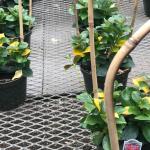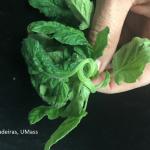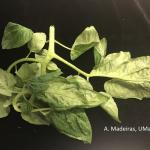Ethylene damage was suspected on mandevilla and tomato plants in greenhouses in separate cases last week. The mandevilla plants exhibited yellowing (chlorosis) and shedding of leaves. The mandevilla plants were located on a bench directly under a heat exchanger. The tomato plants exhibited stunted growth and pronounced downward curling of the leaves and shoots (epinasty). An obstructed chimney vent was the likely source of ethylene in the case of the tomatoes.
Ethylene (C₂H₄) is a colorless, odorless gas that is a naturally occurring plant hormone involved in flower senescence and fruit production. Exposure to ethylene at concentrations greater than 0.1 ppm can cause plant injury. The effects of ethylene on greenhouse crops vary with plant species, cultivar, growth stage, length of exposure, ethylene concentration and temperature. At lower temperatures, ethylene has less impact. For a list of plants and their sensitivity to ethylene, visit: http://www.hort.cornell.edu/mattson/leatherwood
Depending on plant species, symptoms of ethylene exposure include: yellowing (chlorosis) of leaves, shedding of leaves, shedding of flower petals, flower bud abortion, premature aging of flowers, stunted growth and downward bent leaves that look wilted but turgid (epinasty). Note that similar symptoms may be caused by compost that is contaminated with herbicide. Keep an eye on plants for irregular growth and if ethylene damage is suspected, be ready to take steps to identify the source of the problem and eliminate the cause.
The most common source of ethylene in the greenhouse is from heaters that are not functioning properly or heat exchangers that are cracked. Ethylene can result from incomplete combustion in the heater. Greenhouse heaters should be maintained so that they are running properly. Check the heat exchanger annually to ensure that there are no cracks. Also check gas lines for leaks and inspect exhaust chimneys and vents regularly for leaks and obstructions.
If you suspect an ethylene problem in the greenhouse, indicator plants can be used to verify the presence of ethylene. Tomato plants are the most commonly used indicator, as tomato plants are very sensitive to ethylene and typically exhibit injury within 24 hours. Baby’s breath euphorbia (Euphorbia hypericifolia) and Mexican heather (Cuphea hyssopifolia) are also very sensitive to ethylene. Use indicator plants that have not previously been exposed to ethylene and place them near the furnace or heat exchanger, and also at locations further away.
The most reliable method to detect ethylene is by sending an air sample to a commercial or University lab that has the capability of making ethylene measurements, such as the North Carolina State University Plant Disease and Insect Clinic (http://www.cals.ncsu.edu/plantpath/extension/clinic/). Contact the lab for sample submission instructions and fees.
If an ethylene problem is detected in the greenhouse, make sure that you do periodic ventilation of the greenhouse with clean outside air, and address the source of the ethylene as soon as possible.
Resources
Neil S Mattson, Cornell University 2015 e-Gro article. Ethylene in the greenhouse: https://e-gro.org/pdf/2015_415.pdf
Geoffrey Njue and Angela Madeiras, UMass Extension




